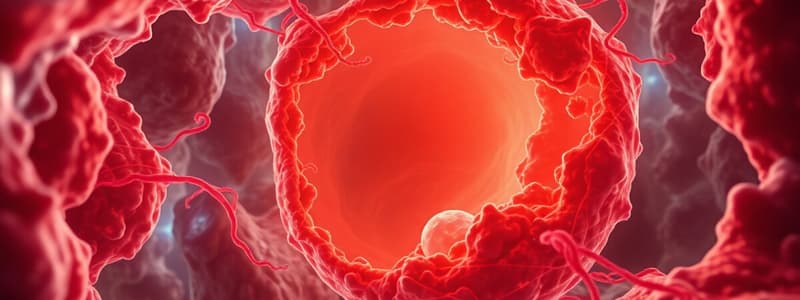Podcast
Questions and Answers
Which of the following accurately describes the role of cytotrophoblasts in placental development?
Which of the following accurately describes the role of cytotrophoblasts in placental development?
- They invade maternal spiral arteries, ensuring proper blood flow to the placenta. (correct)
- They are extravillous trophoblasts found primarily in the third trimester placental villi.
- They directly maintain biochemical balance in the maternal-fetal circulation.
- They are fully differentiated epithelial cells that produce hCG.
What is the primary functional difference between cytotrophoblasts and syncytiotrophoblasts in the placenta?
What is the primary functional difference between cytotrophoblasts and syncytiotrophoblasts in the placenta?
- Cytotrophoblasts are undifferentiated and invasive, while syncytiotrophoblasts are differentiated and regulate maternal-fetal exchange. (correct)
- Cytotrophoblasts are found in third trimester villi, while syncytiotrophoblasts are found in first trimester villi.
- Cytotrophoblasts produce hPL, while syncytiotrophoblasts produce hCG.
- Cytotrophoblasts are involved in angiogenesis, while syncytiotrophoblasts are involved in opening spiral arteries.
A patient is diagnosed with preeclampsia. Which placental abnormality is most likely contributing to this condition?
A patient is diagnosed with preeclampsia. Which placental abnormality is most likely contributing to this condition?
- Overproduction of human placental lactogen (hPL) by intermediate trophoblasts.
- Excessive invasion of cytotrophoblasts into the myometrium.
- Shallow invasion of cytotrophoblasts, leading to un-opened spiral arteries. (correct)
- Formation of placental site trophoblastic tumor.
Which of the following is a characteristic feature of placental villi in the third trimester compared to the first trimester?
Which of the following is a characteristic feature of placental villi in the third trimester compared to the first trimester?
A patient with preeclampsia develops hemolytic anemia, elevated liver enzymes, and low platelets. This progression indicates which complication?
A patient with preeclampsia develops hemolytic anemia, elevated liver enzymes, and low platelets. This progression indicates which complication?
Elevated levels of human chorionic gonadotropin (hCG) are often associated with hydatidiform moles. What characteristic of hydatidiform moles leads to this hormonal elevation?
Elevated levels of human chorionic gonadotropin (hCG) are often associated with hydatidiform moles. What characteristic of hydatidiform moles leads to this hormonal elevation?
Which of the following pathological conditions arises from extravillous trophoblasts at the implantation site?
Which of the following pathological conditions arises from extravillous trophoblasts at the implantation site?
A 45-year-old patient presents with symptoms suggestive of a molar pregnancy. What factor in her history would increase the likelihood of a hydatidiform mole?
A 45-year-old patient presents with symptoms suggestive of a molar pregnancy. What factor in her history would increase the likelihood of a hydatidiform mole?
A patient presents with a triploid karyotype and hydropic villi alongside some normal villi. Which type of molar pregnancy is most likely?
A patient presents with a triploid karyotype and hydropic villi alongside some normal villi. Which type of molar pregnancy is most likely?
Following evacuation of a complete hydatidiform mole, a patient's hCG levels remain elevated. This scenario is most indicative of which condition?
Following evacuation of a complete hydatidiform mole, a patient's hCG levels remain elevated. This scenario is most indicative of which condition?
Which of the following is a key differentiating factor between gestational and non-gestational choriocarcinoma?
Which of the following is a key differentiating factor between gestational and non-gestational choriocarcinoma?
A patient presents with abnormal uterine bleeding months after a healthy pregnancy. Her hCG levels are only slightly elevated, and placental lactogen is detected. What condition is most likely?
A patient presents with abnormal uterine bleeding months after a healthy pregnancy. Her hCG levels are only slightly elevated, and placental lactogen is detected. What condition is most likely?
Which characteristic is associated with a complete hydatidiform mole?
Which characteristic is associated with a complete hydatidiform mole?
Invasive moles are characterized by which of the following?
Invasive moles are characterized by which of the following?
A patient diagnosed with choriocarcinoma is undergoing treatment. Which of the following clinical findings would be most indicative of a positive response to chemotherapy?
A patient diagnosed with choriocarcinoma is undergoing treatment. Which of the following clinical findings would be most indicative of a positive response to chemotherapy?
Histologically, placental site trophoblastic tumors are characterized by the proliferation of which cell type?
Histologically, placental site trophoblastic tumors are characterized by the proliferation of which cell type?
What is the primary initial treatment for a hydatidiform mole?
What is the primary initial treatment for a hydatidiform mole?
Which of the following is a possible complication of invasive mole if left untreated?
Which of the following is a possible complication of invasive mole if left untreated?
Flashcards
Cytotrophoblasts
Cytotrophoblasts
Undifferentiated placental cells that give rise to syncytiotrophoblasts and invade maternal spiral arteries.
Syncytiotrophoblasts
Syncytiotrophoblasts
Fully differentiated epithelial cells in direct contact with maternal blood, producing hormones like hCG.
Intermediate Trophoblasts
Intermediate Trophoblasts
Extravillous trophoblasts found in the implantation site that produce human placental lactogen (hPL).
Preeclampsia
Preeclampsia
Signup and view all the flashcards
Eclampsia
Eclampsia
Signup and view all the flashcards
HELLP Syndrome
HELLP Syndrome
Signup and view all the flashcards
Gestational Trophoblastic Disease (GTD)
Gestational Trophoblastic Disease (GTD)
Signup and view all the flashcards
Hydatidiform Mole
Hydatidiform Mole
Signup and view all the flashcards
Complete Hydatidiform Mole
Complete Hydatidiform Mole
Signup and view all the flashcards
Partial Hydatidiform Mole
Partial Hydatidiform Mole
Signup and view all the flashcards
Hydatidiform Mole Treatment
Hydatidiform Mole Treatment
Signup and view all the flashcards
Invasive Mole
Invasive Mole
Signup and view all the flashcards
Choriocarcinoma
Choriocarcinoma
Signup and view all the flashcards
Choriocarcinoma Metastasis
Choriocarcinoma Metastasis
Signup and view all the flashcards
Placental Site Trophoblastic Tumor (PSTT)
Placental Site Trophoblastic Tumor (PSTT)
Signup and view all the flashcards
Invasive Mole Indicator
Invasive Mole Indicator
Signup and view all the flashcards
Gestational Choriocarcinoma DNA Source
Gestational Choriocarcinoma DNA Source
Signup and view all the flashcards
Placental Site Trophoblastic Tumor (PSTT) Presentation
Placental Site Trophoblastic Tumor (PSTT) Presentation
Signup and view all the flashcards
Study Notes
Placental Cell Types and Functions
- Cytotrophoblasts are undifferentiated cells that give rise to syncytiotrophoblasts.
- Cytotrophoblasts invade maternal spiral arteries to ensure proper blood flow to the placenta.
- Shallow invasion of cytotrophoblasts can lead to preeclampsia.
- Syncytiotrophoblasts are fully differentiated epithelial cells in direct contact with maternal blood.
- Syncytiotrophoblasts maintain biochemical balance in maternal-fetal circulation.
- Syncytiotrophoblasts are an endocrine organ that produces hormones like human chorionic gonadotropin (hCG).
- Syncytiotrophoblasts play a role in angiogenesis.
- Intermediate trophoblasts are extravillous trophoblasts found in the implantation site.
- Intermediate trophoblasts can give rise to placental site trophoblastic tumors.
- Intermediate trophoblasts produce human placental lactogen (hPL), which can be used as a diagnostic marker.
- First trimester placental villi are large with abundant mesenchymal cells
- Third trimester placental villi have more capillaries and a thinner layer of cytotrophoblasts and syncytiotrophoblasts
Preeclampsia and Eclampsia
- Preeclampsia involves hypertension, edema, and proteinuria, usually appearing in the third trimester.
- Eclampsia is the progression of preeclampsia with the development of convulsions.
- 10% of preeclampsia patients develop HELLP syndrome (hemolytic anemia, elevated liver enzymes, low platelets).
- Preeclampsia is caused by hypoxia due to abnormal placental vasculature and imbalance of certain factors
- Angiogenic factors lead to widespread maternal endothelial dysfunction and coagulation abnormalities.
- Preeclampsia symptoms typically resolve after delivery
- In a healthy placenta, cytotrophoblasts invade the decidua and myometrium, opening spiral arteries
- In preeclampsia, cytotrophoblast invasion is shallow, leading to unopen spiral arteries, causing hypoxia
Gestational Trophoblastic Disease (GTD)
- GTD involves the proliferation of villous and/or trophoblastic placental tissue.
- GTD includes hydatidiform mole (partial or complete), invasive mole, choriocarcinoma, and placental site trophoblastic tumor.
Hydatidiform Mole
- Hydatidiform Mole, "hydatidi" means watery vesicle; the term refers to grape-like swellings of chorionic villi.
- Diagnosed earlier now (around 9 weeks) due to ultrasonography, revealing dilated villi and enlarged uterus.
- Laboratory tests find that hCG levels rise more rapidly and are higher than in a healthy pregnancy.
- More common in teenagers and individuals in their 40s to 50s.
- Gestational cause of hydatidiform moles: fertilization by sperm with excess paternal genetic material.
Complete Mole vs. Partial Mole
- Complete Mole: All genetic material comes from the sperm, none from the egg.
- Usually diploid (46XX).
- All chorionic villi are abnormal.
- Not compatible with embryogenesis.
- Increased risk of subsequent choriocarcinoma and invasive mole.
- Partial Mole: Two sperm fertilize an ovum.
- Results in a triploid lesion (XXX or XXY).
- Has hydropic swollen villi mixed with normal chorionic villi.
- Compatible with early embryogenesis but not with a term pregnancy.
- May identify fetal tissue.
- Increased risk of invasive mole, but no increased risk of choriocarcinoma.
- The complete mole consists of an empty ovum fertilized by sperm, which duplicates, forming an abnormal chorionic vili
- The partial mole consists of sperm fertilizing a normal ovum, resulting in a baby with abnormalities and hydropic vili
- Complete moles show entire placenta composed of clear fluid bubbles and enlarged villi microscopically
- Partial moles show some hydropic villi alongside a healthy placenta
Hydatidiform Mole Treatment
- Treatment usually involves curettage and many can present with spontaneous miscarriage
- After curettage, monitor hCG levels for 6 months to a year to ensure they fall to non-pregnant levels.
- If hCG levels do not decrease, it may indicate an invasive mole.
Invasive Mole
- Hydropic villi penetrate into the uterine wall and do not get cleared out during curage
- Persist in uterine wall, continuing to grow, and may perforate the uterine wall.
- Hydropic villi may embolize to distant sites, but this isn't considered metastasis because they do not continue to proliferate.
- Patients with invasive mole have persistently elevated hCG levels, vaginal bleeding, or irregular uterine enlargement.
- Invasive mole responds well to chemotherapy, but may require hysterectomy if uterine rupture occurs.
- Histologically, invasive moles show enlarged hydropic villi with trophoblastic proliferation invading into the myometrium.
Choriocarcinoma
- Malignant neoplasm of trophoblastic cells.
- Gestational choriocarcinoma has paternally derived DNA.
- Non-gestational choriocarcinoma arises from germ cells of the ovaries, testes, or mediastinum, lacking paternally derived DNA.
- Gestational choriocarcinoma occurs in about 1 in 20,000-30,000 pregnancies in the U.S.
- Can follow complete hydatidiform mole, previous abortion, healthy pregnancy, or ectopic pregnancy.
- Gestational choriocarcinoma is aggressive, rapidly invasive, and metastasizes widely, yet responds well to chemotherapy.
- Non-gestational choriocarcinoma is less sensitive to chemotherapy and has a worse prognosis.
- Patients present with irregular vaginal spotting and with a bloody brown fluid, months after a healthy pregnancy, miscarriage, or curettage.
- hCG levels are much higher than in a molar pregnancy; some tumors produce only small amounts of hCG.
- Metastasis commonly occurs to the lungs, vagina, brain, and other sites.
- Evacuation of the uterus and chemotherapy result in about 100% remission and a high rate of cure with subsequent healthy pregnancies.
- Tumors are fleshy, with extensive necrosis and hemorrhage.
- Microscopically, shows proliferating cytotrophoblasts and syncytiotrophoblasts with mitotic figures invading into myometrium and blood vessels.
Placental Site Trophoblastic Tumor
- Uncommon, making up less than 2% of gestational trophoblastic neoplasms.
- Neoplastic proliferation of intermediate trophoblasts.
- May arise a few months after a healthy pregnancy, spontaneous abortion, or molar pregnancy.
- Patients present with a uterine mass, abnormal uterine bleeding, or amenorrhea.
- May have a small increase in hCG, but diagnosis relies of detection of human placental lactogen (hPL).
- Microscopically, malignant cells diffusely infiltrate the endomyometrium.
- Prognosis is excellent with localized disease, but poor with disseminated disease.
- Histological appearance shows smooth muscle bundles of the myometrium invaded by intermediate trophoblasts.
Studying That Suits You
Use AI to generate personalized quizzes and flashcards to suit your learning preferences.
Description
An overview of placental cell types and their functions. The lesson covers cytotrophoblasts, syncytiotrophoblasts and intermediate trophoblasts. It also touches on the roles of these cells in maintaining biochemical balance, hormone production, and potential tumor development.




